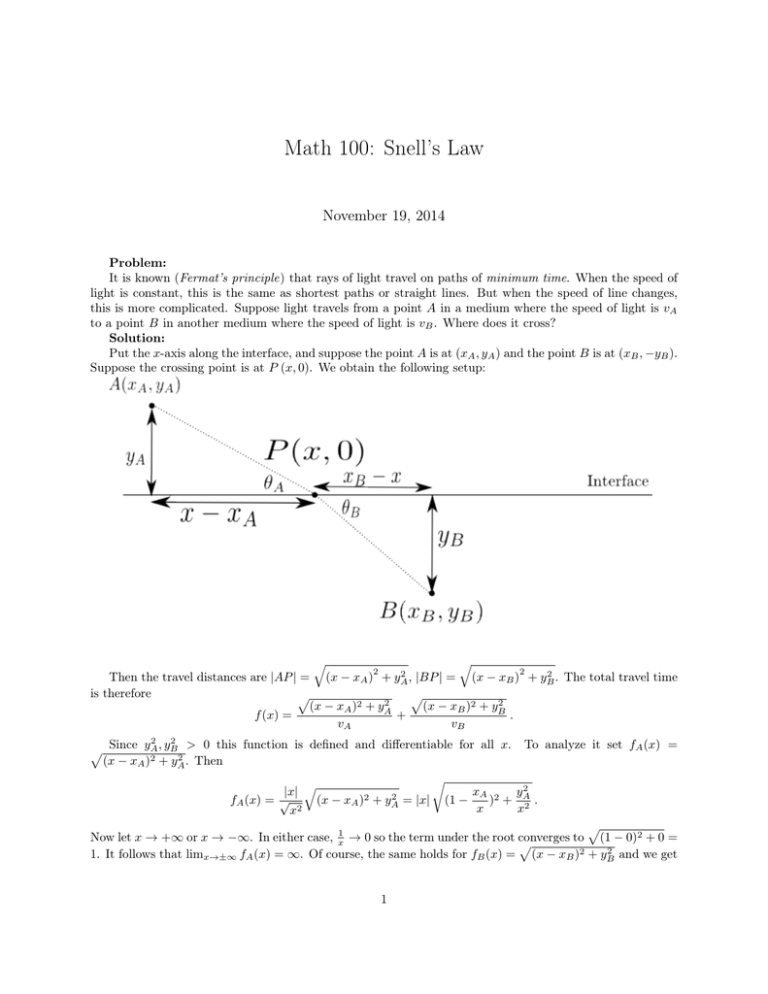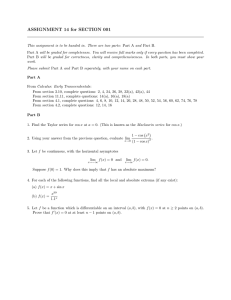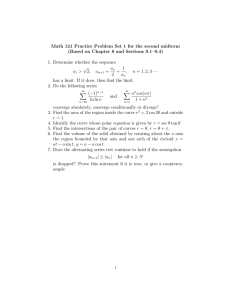Math 100: Snell’s Law November 19, 2014
advertisement

Math 100: Snell’s Law November 19, 2014 Problem: It is known (Fermat’s principle) that rays of light travel on paths of minimum time. When the speed of light is constant, this is the same as shortest paths or straight lines. But when the speed of line changes, this is more complicated. Suppose light travels from a point A in a medium where the speed of light is vA to a point B in another medium where the speed of light is vB . Where does it cross? Solution: Put the x-axis along the interface, and suppose the point A is at (xA , yA ) and the point B is at (xB , −yB ). Suppose the crossing point is at P (x, 0). We obtain the following setup: q q 2 2 2 , |BP | = 2 . The total travel time Then the travel distances are |AP | = (x − xA ) + yA (x − xB ) + yB is therefore p p 2 2 (x − xA )2 + yA (x − xB )2 + yB + . f (x) = vA vB 2 2 p Since yA , yB > 0 this function is defined and differentiable for all x. To analyze it set fA (x) = 2 . Then 2 (x − xA ) + yA r q 2 |x| xA 2 yA 2 2 fA (x) = √ (x − xA ) + yA = |x| (1 − ) + 2. x x x2 p Now let x → +∞ or x → −∞. In either case, x1 → 0 so the term under the root converges to (1 − 0)2 + 0 = p 2 and we get 1. It follows that limx→±∞ fA (x) = ∞. Of course, the same holds for fB (x) = (x − xB )2 + yB 1 that lim f (x) = lim x→±∞ x→±∞ fA (x) fB (x) + vA vB = ∞. It follows that f (x) achieves its minimum at some finite x, which is therefore a zero of the derivative. We now calculate: x − xA =p = cos θA 2 (x − xA )2 + yA x − xB =p = − cos θB 2 (x − xB )2 + yB 2(x − xA ) fA0 (x) = p 2 2 (x − xA )2 + yA x − xB fB0 (x) = p 2 (x − xB )2 + yB where θA , θB are the angles of refraction in the following diagram: We conclude that cos θA cos θB d fA (x) fB (x) + = − . f 0 (x) = dx vA vB vA vB In particular, f 0 (x) = 0 occurs if and only if cos θA vA − cos θB vB = 0 that is if cos θA cos θB = vA vB which we rearrange as cos θA vA = . cos θB vB 2





